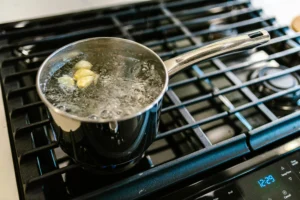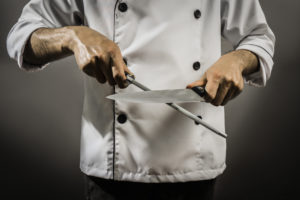06 Aug Safety in the Kitchen
Safety in the Kitchen
The food industry is responsible for following safe handling and delivery procedures. 123ce provides ACF-Approved courses in the sanitation and safety area, including comprehensive reviews of food service sanitation and safety regulations in order to prevent foodborne illness outbreaks. Chefs can certify or recertify with the ACF in 123ce’s Chef Sanitation and Safety courses.
Besides being familiar and updated with information to guard against food-borne illnesses, additional precautions to avoid injury, accidents, and mishaps in the kitchen are important to review for the sake of your employees. The following safety measures should be practiced regularly. To keep your employees safe, consider each possible hazard and identify ways your kitchen can improve its safeguard.
Health and Hygiene
Do not expect your employees to be at work if they are showing symptoms of any cold or illness. Keep any burn or break in the skin covered with a clean, waterproof bandage. Cover the face with a tissue when coughing or sneezing and wash hands afterward.
Keep hair clean and neat, pulled back and use hair nets, if necessary. Fingernails should be kept short and well maintained, with no polish. Keep hands away from hair and face when working with food.
Fire Safety
It takes only a few seconds for a simple flare-up to turn into a full-scale fire. Grease fires and electrical fires are not uncommon in busy kitchens. A comprehensive fire safety plan should be in place and constantly reviewed with all your employees. Fire extinguishers should be located in easily accessible areas. Employees should know the building evacuation plan, what the fire alarm sounds like, how to turn on the fire alarm, where to find a fire extinguisher, and how to use it.
Proper maintenance of extinguishers and timely inspections by your local fire department are vital. The fire extinguisher should be used to put out all fires in a kitchen – water should never be used because this will eliminate chances of accidentally increasing the dangers of grease and electrical fires.
Additionally, to avoid causing a fire, any chef’s whites that begin to fray or pill should be patched or replaced immediately.
Preventing Slips & Falls
Of course, the types of shoes your chefs wear factor into the likeliness of a slip. Further than that, keeping floors clean, uncluttered and/or treating floors with slip-resistant coatings or chemical treatments will safeguard against slips and falls. Establish a floor cleaning schedule and use cleaning chemicals with good grease-removal and slip-resistance properties. Clean up spills immediately and post “caution” or “wet floor” signs until the floor is dry.
Pay extra attention to your ice machines because of the large volume of water involved.
Encourage your entire team to use professional language when employees are moving through crowded areas. Phrases such as “behind you,” “hot,” “and “corner” help prevent collisions and falls. Communication is key – especially in a kitchen.
Employees should never carry large loads that obstruct their vision, unless absolutely necessary and should then be guided by a few helpers to aide navigation.
Sharp Knives Safety
Take time to train new employees on proper knife handling. Although the chef’s previous training may have taught them knife handling skills, it is more helpful to have your entire staff using the exact same knife etiquette.
Burn Prevention
Provide training for all employees on recognizing and controlling burn hazards. Also, take these protective measures:
- Make potholders easily accessible.
- Provide adequate room for safe handling of pots on the range top.
- Install safety devices such as temperature and pressure relief valves to help reduce the potential for explosion of pressurized water heating systems.
- Reduce the temperature on your hot water heaters to reduce the potential for scalding when using hot water in sinks.
- Train employees to stand back when using the automated lid on a braising pan or steam-jacketed kettle.
- Only allow trained employees to condition deep fryer grease, and only with proper protective equipment. Post written procedures specific to the equipment in use.
Hazard Communication
Restaurants need to pay attention to the U.S. Department of Labor Occupational Safety & Health Administration’s (OSHA) Hazard Communication Standard. This rule requires employers who have any potentially-hazardous chemical in the workplace, such as cleaning solvents or pesticides, to provide information about these chemicals to employees through labels on containers, material safety data sheets (a manufacturer-provided data sheet), and training programs.
Cleaning chemicals should be stored in a separate area away from food and heat sources, in their original container and with a tight lid. Employees should be taught to:
- Never mix chemicals.
- Use chemicals only in well ventilated areas.
- Follow label directions when disposing of chemical containers.
- Wash hands after using or touching any chemical or equipment used with a chemical.



